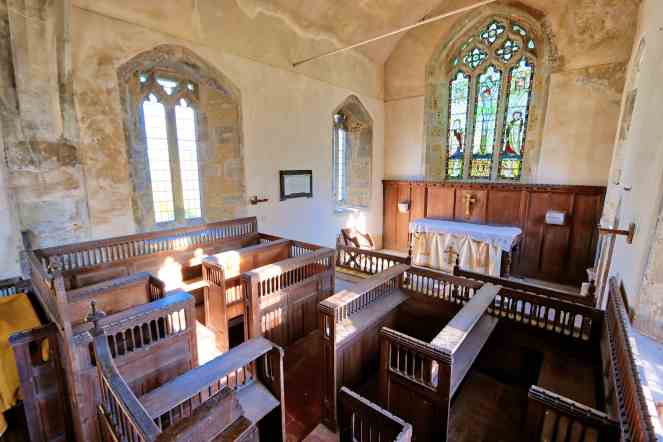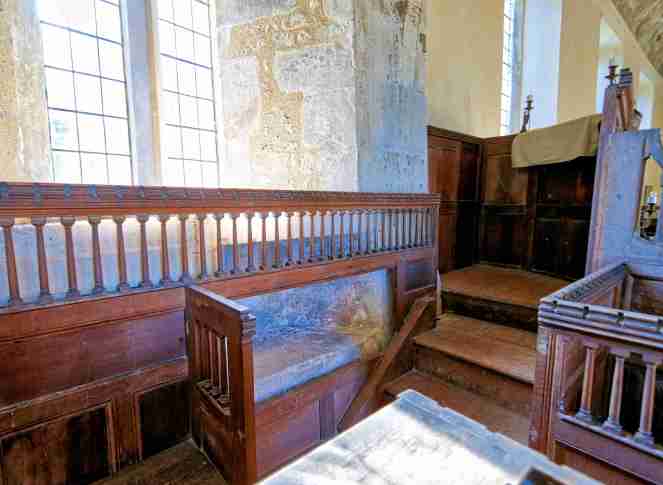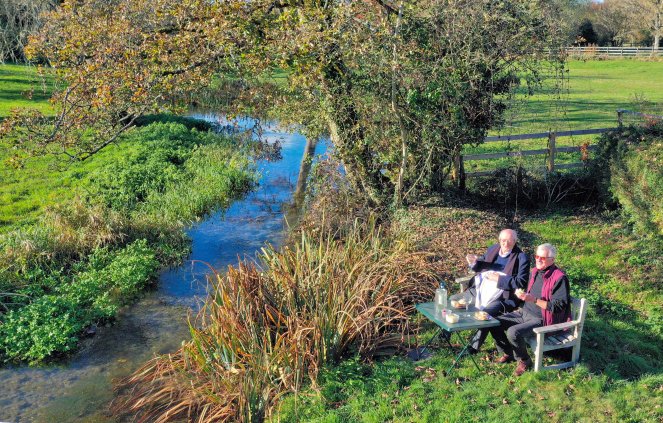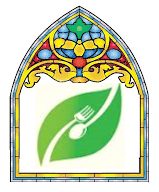What a strange, unsettling year this has been – and it’s not over yet. However, the good news is that our salvation in the form of a vaccination is apparently close at hand and we octogenarians are going to be at the front of the queue. I shall ignore the scurrilous talk on social media of expendable guinea pigs and be both willing and grateful to receive it. But, for the present, we remain in the twilight zone of another lockdown and BQ and I only just managed our visit to the Wilton area the day before the shutters fell. Even so there was so much talk of risk and danger that, for the first time we substituted a picnic instead of a restaurant lunch for the ‘Dine’ element of the day. And what a gorgeous day it was, unusually warm autumn sunshine with just a hint of a gentle breeze.
I arrived to collect BQ from his Southampton home in the mid morning and, after a coffee and a catch-up on family news, we made our way towards Salisbury avoiding the horrors of the Salisbury bypass by circling the city to the west. Of necessity our day’s destinations were two redundant churches in the care of that worthy organisation the Church Conservation Trust; all other churches being closed to the public except for brief periods of private prayer.
Church of St. Mary and St. Lawrence, Stratford Tony

Even with the use of the satnav, this church was so hard to find that eventually, in frustration, I left BQ in the car and with the help of the ordnance survey map continued by foot along a well used path that followed the banks of chalk stream until, after a while, I arrived at a collection of cottages. This was surely our destination, the hamlet of Stratford Tony, for there on the brow of a hill was a church which surely must be that of St. Mary and St. Lawrence. But here was the next problem – the only access seemed to be by a steep muddy path and I wasn’t sure whether BQ was capable of an ascent, but I should have had more faith for, although it was a slow and laboured climb, he made it. Later on we were faced with the descent which was rather more challenging but, with the aid of his trusty walking stick on one side and a steadying arm on the other, to my great relief he returned to level ground unscathed.
When the time came to do some research for this entry I was amused by the opening sentence in one of our guides:- ‘The church of St Mary and St Lawrence at Stratford Tony is a quiet country church located in a secluded – one might even say scarcely accessible – location near the River Ebble.‘

As I have mentioned before BQ has long been a luddite when it comes to modern technology – up to now that is – as, under pressure from grandchildren, he is at last the owner of a mobile phone and used it to great effect when he took this, his first ever photo to be used in Dine and Divine. I am sure that it will be the first of many.
The small community of Stratford Tony that we see here today is a fraction of it’s size that it was when the church was built during the 14th and 15th centuries when it had a population of well over 100. However, there had been a village here long before that, at least since Roman times, as it was here that the Roman Road from Salisbury to Blandford crossed the River Ebble. Hence the first part of its name – Strat (Street) ford. The second part wasn’t added until the 11th century when William the Conqueror’s standard bearer at the Battle of Hastings – Ralph de Toni was given the manor in recognition of his services.
It is likely that the present building stands on the foundations of an earlier church. The chancel dates from the 14th century and is constructed of flint with stone dressings. In the south wall there is a piscina of Purbeck marble which, like the 13th-century font, was probably part of the previous building. The tower arch and porch date from about 1500, the tower is typically Wiltshire, with blocks of stone alternating with panels of flint.
Responsibility for the preservation of the building was transferred to the Churches Conservation Trust in 1986, as although the building had previously been lovingly cared for, the cost of the required repairs to the roof and stonework was just too great for the tiny community, Work commenced immediately under the supervision of the redoubtable Mrs Margaret Maxwell and was completed in 1988.


Two views of the interior which has scarcely changed during the past 300 years. It is beautifully fitted out, the standard of work in the pews, chancel stalls and screen is exceptional and, to quote an early guidebook, the overall effect enhances the building’s ‘wonderful serenity’.

The chancel and the perfectly petit choir stalls. Above the altar sits the only coloured glass window in the building. It was installed during the programme of refurbishments carried out in 1882 and is the work of the most eminent of the 19th century stained glass suppliers, Charles Eamer Kempe. Kempe had originally considered entering holy orders, but a habitual stammer made it clear that his future did not lie with preaching. His interest in stained glass stemmed from his dissatisfaction with glass he ordered from a supplier. He decided that he could do better – and he was right. In 1866 he started his own business in London and became highly successful. Kempe decided early on that he needed to use a trademark, and he chose a wheatsheaf, which appears in the Kempe family coat of arms. Finding the wheatsheaf in a Kempe window is apparently a popular pastime for people exploring Victorian churches! His studios produced over 4,000 stained glass windows during his lifetime and cathedrals at Chester, Gloucester, Hereford, Lichfield, Newcastle upon Tyne, Winchester, and York all contain works by him. A shy man by nature, he never married.

In the recess behind the handrail a leper squint can be seen. These were common in medieval churches and were designed to allow lepers to use the aperture in order to follow the service from the outside of the building without risking infecting the members of the congregation inside. A rather inhuman picture that has an uncanny parallel with the situation we find ourselves in 600 years later where distressed families are forced to communicate with confused elderly loved ones through the closed windows of care homes.
The short flight of stairs lead to the early 17th century pulpit that was reduced in height during the 1882 refurbishment. Quite why is a mystery, perhaps there was a diminutive incumbent parson at the time.

The oldest object in the church – a 13th century Purbeck marble font, a relic from the previous church that stood on this site.
Our Lunch

By the time we descended from the church back to the village green it was time for lunch and by good fortune there was a bench seat perfectly positioned on the side of the River Ebble. Incidentally I had to check on the ordnance survey to confirm that this was indeed the River Ebble that we had read about as it looked more like a stream than a river. The strange truth is that there are two River Ebbles that flow in parallel through Stratford Tony, dividing and rejoining either side of the village – and this is the smaller of the two. But I digress – back to lunch.
In contrast to the very ordinary ham, cheese and tomato sandwiches, the accompanying wine was as close to perfection as one could wish for when dining al fresco. It was a bottle of Waitrose’s finest Pinot Grigio, crisp and dry with a punchy acidity and a slight effervescence. Exquisite! With our usual restraint we had intended to have just the one glass each but I fear that by the time we had finished the last of the petits fours the bottle was drained. I hasten to add that as I was the designated driver it was BQ who had by far and away the lion’s share.
Wilton
And then – on to the charming town of Wilton whose history dates back to the Anglo-Saxons in the 8th century. By the 9th century it was the capital of Wiltunschire, later to be known by the present county name Wiltshire. Nowadays most people know of Wilton because of its association with carpet weaving which began in 1741 after two French weavers were brought across to teach the local people new skills. Carpet manufacture prospered helped by the introduction of the mechanical loom shortly after, together with a plentiful supply of local wool. Manufacture of quality carpets has continued in Wilton to the present day.
St. Mary’s Church
At one time evidence suggests that there were 8 or 9 churches in Wilton but, with the building of the new city of Salisbury nearby, Wilton was eclipsed and, by the 16th century, all churches apart from the original Church of St Mary in the market place had disappeared. Between 1841 and 1845 a completely new ‘Italian Romanesque’ parish church was built for the Herbert family at great cost, and soon afterwards the old church of St Mary was reduced to a picturesque ruin with only the chancel still keeping its roof.

The remnants of the 15th century Church of St Mary. The intact section to the left was the original chancel but now forms the entrance to its 19th century replacement.

On entering the present church, my first impression was that it is surprisingly small and underwhelming and its main purpose seemed to be to glorify the great and good of Wilton by a series of memorial tablets that cover the walls of the chancel. However, some had originally been installed in the earlier church and were more interesting, as they commemorated the lives of less worthy Wilton residents, such as Thomas Mell (d.1625), a servant to the 3rd Earl of Pembroke, and later to Kings James 1 and Charles 1; Edmund Philips (d.1678), ‘sweeper of Burbridge’ (a suburb of Wilton) and ‘farer’ (i.e. farrier) to the Earl of Pembroke and John Thomas (d.1798) ‘an eminent Manufacturer of this borough’, a local clothier.


There are three benefaction boards on the walls of the tiny nave that record gifts to the parish and I found this one particularly interesting. I was intrigued by the final paragraph and the significance of 20th January. It must have been an important day if sufficient money had been allocated for bells to be rung on that day in perpetuity. Could it possibly be Robert Sumpton’s birthday? it seems a bit immodest in an otherwise charitable gesture, but after a bit of research I found the christening records of the parish and there he was – christened on 24th January, 1717. By today’s standards, christening a 4 day old infant would be unusual, but in the 18th century when death in infancy was common, an urgent baptism for a newborn was vital in order that it’s soul could not fall into a state of limbo should it not survive. Thankfully such nonsense no longer applies.

BQ’s Impressions
No month of the year has undergone such a bewildering change as November, from the foggy yellow smog of my youth in London, to the warm clear sunshine and bucolic setting of our visit early in the month to Wiltshire. It’s not just the temperature that has changed but strange feasts and celebrations have altered over the years. Our visit therefore sat between the new of Halloween and the old of Guy Fawkes day and still I miss the sight of youngsters with a guy requesting a penny. However perhaps the move from bonfires is responsible for the excellent weather as in the clear blue sky above the church, not a vapour trail in sight.
When visiting churches I have always favoured this time of the year when the low sun illuminates the interior and dark corners and cobwebs become alive with reflected glamour. Not that there were many of the latter in both churches which, despite being redundant, are scrupulously maintained by the Churches Preservation Trust.
After the usual disagreement between me and MW’s sat-nav, we had a pleasant journey into Wiltshire replete with autumn colours which was a delight. Whilst attempting to find our village we speculated on the origin of the name and finally decided Stratford Tony sounded like the country retreat of an East End mobster! As someone who is the recipient of a blue badge the access over a bridge and up a steep hill was not easy, and I was grateful for MW’s shoulder. As usual, after making sure I was safely installed in the church MW exited to attend to his usual activities with his drone. This interlude is always a quiet and reflective opportunity for prayer which somehow feels appropriate in these buildings which have listened to them for centuries. As I prayed I wondered if my request for divine intervention would differ in any way from those during the Black Death in medieval times. To quote the book of Ecclesiasticus perhaps’’There is nothing new under the sun’’. What a delightful nave for this reverie, being brightly lit by the southern windows and the warm sunshine was a tonic compared with the usual dark and cold interiors of unoccupied churches.
MW with his usual painstaking research has covered all the main features in his usual detailed fashion and it would be wrong if I did not admit to a rumbling tum whilst waiting for the goodies of the picnic that would follow our visit. In this respect we were clearly following our mission statement set out three years ago to follow in the manner of the church excursions in the book ‘Keeping on Keeping On’ by Alan Bennett who, together with his companion, regularly ate sandwiches during their visits.
Now might be the time to recall an incident from our past history that is relevant. A great many years ago, together with our families, we went to the Grey Mares Tail waterfall in Scotland to enjoy a picnic in the great outdoors. MW with military efficiency had prepared a feast which was stowed in a large box, but whilst he was absent a few of us started eating tit bits to assuage the growing hunger. On his return MW blew his top as he had prepared a full layout with tablecloth, cutlery and all the accompanying details, and there we were scrabbling in the box like a pack of animals.. This had taught me a lesson so, when picnic time arrived, I remained seated and allowed the master chef to arrange the goodies from a similar box as that from the past. In line with the present times and on the verge of lockdown, the meal was modest but, as before, it was laid out with much aplomb. A passing local resident greeted us and then asked if we would keep a lookout for a lost dog. Would you believe it ! That even in this sublime setting, was my meal to be interrupted by my nemesis – a dog? Thankfully not.
Then on to Wilton which, in the past, has always represented a traffic bottleneck at the end of a long wall when travelling to the west. But now it was a time to stop and enjoy the central ruins and church of St Mary. Although a townie by nature this partial ruin is somewhat disappointing compared with our earlier visit. However, the lit lamp on the altar signified that a further prayer should be offered – which was that at the end of restrictions I would be able to visit the nearby St Mary and St Nicholas church, an extravagant Italianate confection built in Victorian times. Something to look forward to. BQ

Great to hear you’re both well and back on the D&D trail. Thank you for forwarding. Another interesting read and sharp photos. Church leper squint, medieval time – care homes closed windows, 21st Century. All happened before hasn’t it. Looking forward to the next D&D.
LikeLike
Enjoyed having a look around your blog – i shall be back for more of your photos and stories, as you have provided us with such a wealth of much appreciated information.
LikeLike
Thank you Jill. Your comments are much appreciated. Now that the pandemic is in retreat we are hoping to resume our visits in the near future. Just tap ‘follow’ to get an alert when one is published. Kind Regards MW
LikeLike